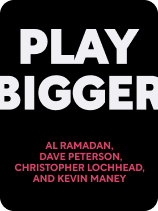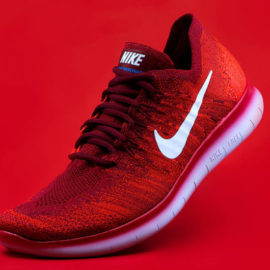

This article is an excerpt from the Shortform book guide to "Play Bigger" by Al Ramadan, Dave Peterson, et al.. Shortform has the world's best summaries and analyses of books you should be reading.
Like this article? Sign up for a free trial here.
What is the book Play Bigger about? What are the main takeaways of the book?
In today’s world, being better just isn’t enough. Play Bigger says you have to create an entirely new market to showcase your product and its solution to consumers’ problems.
Read below for a brief overview of the book Play Bigger.
Play Bigger Overview
In today’s buying landscape, there’s no room for second-tier companies: The top dog of every market usually reaps all the rewards, leaving other companies competing for scraps. This means every company should strive to become a top dog.
Al Ramadan, Christopher Lochhead, and Dave Peterson of the advisory firm Play Bigger, with the help of business writer Kevin Maney, believe the way to do this is not to create a product that’s merely superior to other products in an existing market, but rather to create a brand-new market for your product. In their book Play Bigger, they say you can design this market to specifically highlight your product’s unique assets, thereby making yourself the best and only option in that market—the market winner.
The most recognized and successful companies today created their own markets, revealing to customers a problem they didn’t know they had and then positioning themselves as the only solution.
Part 1: Defining Market Design and Market Winners
Let’s first define the authors’ concept of market design and the market winner. It’s worth noting that the authors’ work experiences come primarily from the tech industry. However, they stress that you can apply these lessons to any business.
(Shortform note: The authors are likely correct in asserting that lessons from the tech industry can apply to more traditional companies, simply because the distinction between tech and non-tech businesses is becoming increasingly fuzzy. Most modern companies—like Goldman Sachs, GE, and Exxon—classify themselves as “tech companies,” at least to a certain degree.)
What Is Market Design?
Market design is the act of creating an entirely new market for your product, claim the authors. You do this by devising a novel solution—not a solution that’s just better than other solutions—to an existing or not-yet-existing problem, often completely altering peoples’ lives and lifestyles and rendering old markets obsolete.
The authors cite Uber as a company that created an entirely new market and solution—ride-hailing services—to solve a problem consumers didn’t know they had: the challenge of finding a taxi when you need one. In Uber’s case, it made traditional taxis (the old market) much less appealing and completely changed how people get around.
When you engage in market design, you craft the market to specifically highlight your product’s unique advantages and the problem it solves, contend the authors. No other company that enters the market will succeed as well as you because the market isn’t designed to accentuate its advantages—it’s designed to accentuate yours. This is in many ways easier than competing in a market that’s saturated with recognized brands and that’s not set up to highlight your product’s assets or the problem it solves.
Furthermore, when you establish a new market based on a new or existing problem, you won’t need to work hard to convince consumers to buy from you, claim the authors. Once they recognize the problem your market will solve, consumers will clamor for a solution—it’s human nature to want to solve a problem, even if it’s one they only just now realized they had. And since your company will be the only one offering any solution in that market (because you’ve only just established it), they’ll turn to you exclusively.
However, if you create a new market for your device, you can succeed in it because you can design the market to highlight your product’s unique features—its relatively low tech capacity. You might thus create a “low-tech devices” market: a market for products that have more limited capabilities than standard smartphones, to solve the problem of tech overwhelm. And once consumers recognize that they, too, have tech overwhelm, they’ll buy only from your company, because you’re the only company around that can solve that problem for them.
The Advantage of Market Design: You Can Become a Market Winner
Designing a new market for your product gives you the greatest chance of becoming a market winner: the most recognized and trusted brand in a market, write the authors. Market winners often become synonymous with their entire markets and usually consume 70 to 80% of the market’s profits and value. Because customers recognize these companies so well and identify them so closely with their market, it’s nearly impossible to compete with them. You want to become a market winner because you’ll be an indomitable force.
Part 2: The Three Steps of Market Design and Becoming a Market Winner
Now that you know what market design is, why to do it, and what its challenges are, let’s discuss the authors’ three steps of designing your new market and becoming its winner.
Step 1: Identify Your Market
The authors write that the first step of designing your market and becoming its winner is to identify your market by pinpointing an unmet need in peoples’ lives or a new way for your existing technology to fill an unmet need. At your low-tech company, you might identify the unmet need for less intrusive technology. Your market, then, becomes the market for low-tech devices.
Step 2: Identify and Express Your Company’s Take
The authors write that once you’ve identified and defined your new market, it’s time to craft your company’s take: an identity, guiding principles, outlook, and story about how your company solves a problem differently than other companies.
Step 3: Implement Your Market Design Through a Big Event
Now that you’ve identified a market and take, reveal them to the world. The best way to do this is through what the authors call a “lightning strike” and what we’ll call a Big Event.
A Big Event is an explosive occasion that introduces your company, market, and product to the world, assert the authors. This is the first step toward getting people to embrace your different (not better) approach to solving a problem. Ensure your Big Event is attention-grabbing and makes a mark in the customer’s mind—you must make a big impression to begin getting people to embrace a new market.
Part 3: Remaining the Market Winner
Now that you’ve solidified your market in customers’ minds and made yourself that market’s winner, the authors explain how to remain the long-term market winner in two steps: 1) by expanding your market or creating another new market and 2) by establishing a flywheel effect in that market.
The authors claim that you must complete the first step because every company eventually reaches most customers in its market and must either create a new market or expand its current market to continue growing. Companies must do this over and over to remain market winners. For instance, you’ll eventually reach all customers who want to minimize their tech use in your low-tech devices market and might therefore expand that market to include customers who not only want to be on their phones less, but also want to use more analog products, by selling paper agendas, notepads, and so on.

———End of Preview———
Like what you just read? Read the rest of the world's best book summary and analysis of Al Ramadan, Dave Peterson, et al.'s "Play Bigger" at Shortform.
Here's what you'll find in our full Play Bigger summary:
- Why financial success doesn't depend on education or intelligence
- Why the key to financial success lies in understanding human behavior
- How to create a financial strategy you can follow for decades






